
Welcome to 'just old flies,' a section of methods and flies that used-to-be. These flies were tied with the only materials available. Long before the advent of 'modern' tying materials, they were created and improved upon at a far slower pace than today's modern counterparts; limited by materials available and the tiers imagination.
Once long gone, there existed a 'fraternity' of anglers who felt an obligation to use only the 'standard' patterns of the day. We hope to bring a bit of nostalgia to these pages and to you. And sometimes what you find here will not always be about fishing. Perhaps you will enjoy them. Perhaps you will fish the flies. Perhaps?
JO'S FLIES
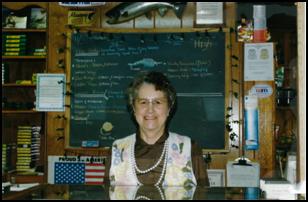 From 1945 to 1992 Josephine Sedlecky-Borsum was the proprietor of Ed's Sport Shop in Baldwin, Michigan. In her 47 year rein as a shop owner and fly tier she tied hundreds of thousands of flies. Most of her customers were local but she did have regular customers from all across the country and even from Europe. Much of her winter was devoted to tying up special orders for her regulars, as well as laying in large quantities of flies for the spring season. Most all the local patterns were tied in the shop either by herself or an occasional employee who possessed the necessary tying skills. Patterns involving synthetics were purchased from commercial outlets like Umpqua or Spirit River.
From 1945 to 1992 Josephine Sedlecky-Borsum was the proprietor of Ed's Sport Shop in Baldwin, Michigan. In her 47 year rein as a shop owner and fly tier she tied hundreds of thousands of flies. Most of her customers were local but she did have regular customers from all across the country and even from Europe. Much of her winter was devoted to tying up special orders for her regulars, as well as laying in large quantities of flies for the spring season. Most all the local patterns were tied in the shop either by herself or an occasional employee who possessed the necessary tying skills. Patterns involving synthetics were purchased from commercial outlets like Umpqua or Spirit River.
Back in the 1950's and early 1960's Jo created many original patterns that were favored by her customers. When asked why they were so popular the response was almost always, "they work!" Jo's was an accomplished fly fisherman. She developed a keen eye for watching the hatches and studying feeding preferences. The patterns she created were tested for productivity. Those that worked became standards in her store and highly sought after by her clients.
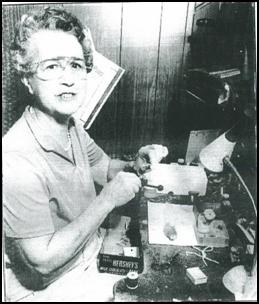 Josephine was a traditional tier for the period. Because she was a business owner she was always conscious of cost and seldom used expensive materials. As a hunter she supplied herself with animal hairs and feathers. Other sportsmen in the area would also keep her supplied with local materials. She always used inexpensive hackle. She had an arrangement with a local poultry farmer who, come butchering time, supplied her with capes, saddles and necks in bulk.
Josephine was a traditional tier for the period. Because she was a business owner she was always conscious of cost and seldom used expensive materials. As a hunter she supplied herself with animal hairs and feathers. Other sportsmen in the area would also keep her supplied with local materials. She always used inexpensive hackle. She had an arrangement with a local poultry farmer who, come butchering time, supplied her with capes, saddles and necks in bulk.
When tying, she always used a 'one continuous thread' technique. She never used a bobbin but had a large clip of-sorts fastened to her tying bench that would supply tension to the thread. She always waxed her own thread and rarely used any colored thread other than black. She only used Mustad Hooks and rarely tied in a size smaller than a #14.
Jo tied all the standard patterns of the day but is most remembered for her own creations. She favored certain materials like calftail for wings and tails, pheasant tail fibers for tails and woodchuck for wings and tails. She was also fond of floss bodies. Other than a little tinsel, some Antron yarns, and little chenille she never used synthetics.
Of all the patterns that she created at least six, her most famous, have survived the test of time. These flies are still tied and fished today by a few loyal fans who know what great producers of fish they really are. The photographs below are of actual flies that were tied by Josephine.
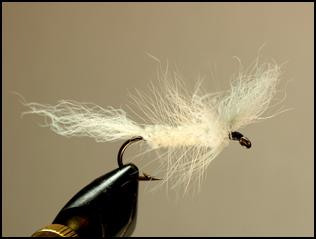 Brown Stone
Brown Stone
Hook: Mustad #9672 (2x Strong) Sz: 10-2
Thread: Black, 3/0
Tail: White Calftail, tied long
Wing: White Calftail, tied upright and divided.
Body: White Chenille
Rib: White Hackle Fibers, two strands,
palmered and wrapped forward
simultaneously.
Hackle: White
The brown stone is fascinating because it is neither brown nor does it represent a stone fly. Where the name came from we will never know. What we do know is that she designed this fly for the Michigan 'Hexagenia' hatch. It also functioned as a great general purpose night fly for the big browns. It was available in a size #1 hook on special order from Josephine. When Jo tied these flies she used bucktail instead of calftail on the larger #1 and #2 hooks. This fly is still tied and marketed locally in the Baldwin area, but now it's called the Albino Hex. Poor storage of this original fly gives the impression that it was tied spent wing. This pattern was developed sometime in the 1950's.
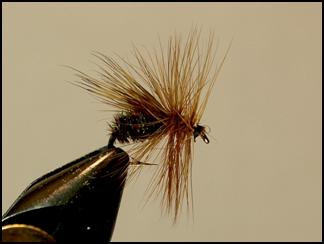 Killer
Killer
Hook: Mustad #94840 Sz: 8-14
Thread: Black, 6/0
Body: Peacock Herl, tied heavy
Wing: Woodchuck, tied trude style
Hackle: Brown, tied heavy
We know that Jo developed this pattern as a generalized caddis pattern. I have been fishing with this pattern since 1988. It is my favorite 'go to' caddis pattern. The magic of peacock will never let you down. While interviewing some of Jo's old friends I discovered that this is the #1 fly preference in their entire fly arsenal. This fly was developed by Josephine in the 1950's.
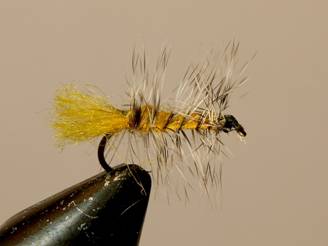 Hot Mustard
Hot Mustard
Hook: Mustad #94840 Sz: 10-14
Thread: Black, 6/0
Body: Gold Antron Yarn, extended
beyond the bend of the hook.
Rib: Grizzly Hackle, palmered
This easily tied fly was Jo's rendition of the Little Yellow Stone. It was favored among the locals as a fly that could be fished from midsummer into late fall. It could also be fished during the Big Golden Stone hatch. This fly was developed in the early 1960's.
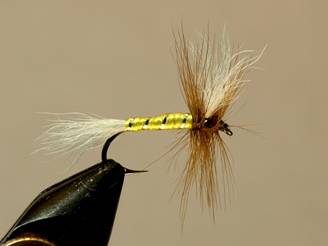 Lady Jo Caddis
Lady Jo Caddis
Hook: Mustad #94840 Sz: 10-4
Thread: Black, 6/0
Tail: White Calftail
Wing: White Calftail, tied upright and
divided.
Body: Yellow Floss
Rib: Gold Tinsel
Hackle: Brown, tied heavy
This was one of Jo's hex patterns, basically tied for the Michigan 'Hexagenia' hatch. In the larger sizes it was used at night. She also tied this fly on a Mustad #7948A hook. In smaller sizes it became a great searching pattern that could be used during the day as well. She created this fly in the 1950's.
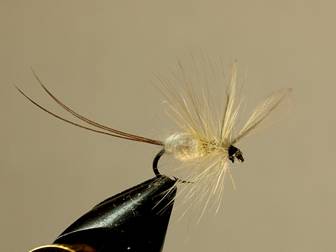 Tan Fury
Tan Fury
Hook: Mustad #94840 Sz: 10-14
Thread: Black, 6/0
Tail: 2 Pheasant Tail Fibers, tied long
Wing: Blue Dun, tied upright and
divided.
Body: Tan Angora (rabbit), tied plump
and spiky looking.
Hackle: Light Ginger
The one fly that is most closely associated with Josephine, would be the Tan Fury. This was Jo's answer to the Light Cahill. It can be used throughout the season when there are light colored mayflies on the water. She also tied this pattern on a Mustad #7948A. Every fisherman I interviewed has some in their tackle box or their collections. Jo's Tan Fury is their all-around 'go to' fly. This fly was so popular that on any single day she might completely sell out her inventory of them and would often times tie late into the evenings just to replenish this one pattern. She developed this pattern in the 1950's.
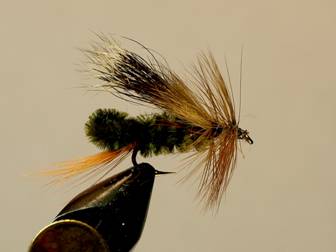 Top Hopper
Top Hopper
Hook: Mustad #94840 Sz: 8-12
Thread: Black, 6/0
Tail: Orange Hackle Fibers
Body: Dark Olive Green Chenille,
extended over the tail by
looping the chenille.
Wing: Woodchuck, extended past the
bend of the hook, tied trude.
Hackle: Brown, tied heavy.
I spoke with people who tie and fish with this pattern today. With this pattern Josephine had many variations; the most common was a light green (lime) chenille body. The tail fibers could be red or yellow as well. She had another variation where she replaced the woodchuck wing with two turkey quill wings tied down over the body. The tail is tied out straight from the hook shank. The extended chenille butt places pressure on the tail fibers which, over a period of time, pushes them into a slanting, downward position. On request Jo would also tie these up in a size #6. This pattern was originated by Jo in the early 1960's.
Josephine Sedlecky-Borsum, a self-taught, modest, "little old country girl tier," who had a true passion and talent for tying flies was honored in 1987 when the Smithsonian Institute invited her to tie flies for their summer Folk life Festival.
The last few years before she retired, tying became difficult for her because of her failing eye site and arthritis that took her off the water a few years earlier. Jo retired in 1992. She passed away three years later on January 21, 1995.
See you on the water…..
Tom Deschaine
Acknowledgements
I am deeply indebted to those people who assisted with the articles I have written on Josephine. Special thanks to Mr. David Roller of Pere Marquette Outfitters and to Mr. Jason Frank of Baldwin Bait & Tackle, both of whom worked with Jo at Ed's Sport Shop. They both have an extensive knowledge of her patterns.
I'd also like to thank Mr. Douglas Loomis, the current owner of Ed's Sport Shop for allowing me to photograph his extensive collection of Jo's flies. And, to Mr. David Stewart for allowing me to photograph his collection of Jo's flies which are currently in storage at the Pere Marquette River Lodge.
Special thanks is also due to all the family members and friends of Josephine who supplied me with photos and newspaper clippings and allowed me to interview them.
Copyright 2011©Deschaine
[ HOME ]
[ Search ] [ Contact FAOL ] [ Media Kit ]